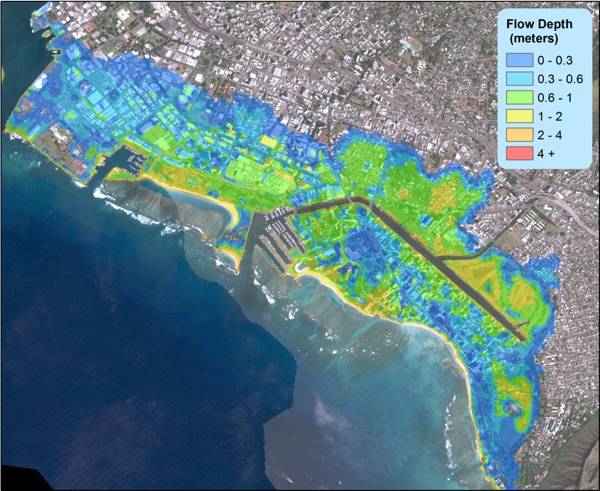A new study by researchers at the University of Hawaii at Manoa School of Ocean and Earth Science and Technology indicates that as the climate changes in the coming decades, the northward shift of hurricanes toward the Hawaiian Islands will increase chances of landfall, and storm surge will pose severe flood risks to population and infrastructure along coastlines and further inland.
By studying information from computer models for climate change, hurricane formation and intensity, storm surge, and waves, Ning Li, ocean wave model systems specialist and lead author of the study, and her co-authors estimated future vulnerability to the combined effects of sea-level rise and the closer proximity of hurricanes.
Li acknowledged the focus of the study is urban Honolulu, but added, “I think the Big Island will be the first to taste it. In the last few years, there have been a few hurricanes that have (approached) the Big Island from the east, so I think we’ve already seen the signal.”
According to the study’s authors, climate change can potentially increase the severity of natural hazards through the end of the century, thereby reducing the reliability or safety of structures.
“With high tide and the projected sea-level rise, the … results from a direct landfall of an Iniki-like hurricane on the south shore of Oahu showed extensive inundation of downtown Honolulu and Waikiki,” Li said. “Other hurricanes passing near Oahu can also produce severe surge and high surf, causing coastal flooding.
“I think there’s going to be a lot of impacts; definitely the tourism industry is one of them. I do want to bring attention … that we just studied the surge. When a hurricane comes, there is heavy rain and wind damage that is not included in our study.”
“The findings of our study were not a surprise,” added Kwok Fai Cheung, senior author of the study and professor of ocean and resources engineering. “Our recent experience with increasing number of storms tracking closer to the islands — for example, Hurricane Guillermo in 2015, Hurricane Celia, Darby and Lester in 2016, Hurricane Lane and Olivia in 2018 — has already confirmed the change of hurricane patterns. The damage caused by Hurricanes Lane and Olivia underscores the importance and urgency of coastal storm hazards mitigation. This research should draw attention from state and federal agencies.”
Jonathan Price, professor of geography at the University of Hawaii at Hilo, said the Big Island will face different impacts than Oahu.
“It’s a little bit apples and oranges,” he said in reaction to the study. “We have significant agricultural interests, so that’s a different kind of potential damage. That was something that we saw with (Hurricane Michael) in the Florida panhandle … and Iselle, too, especially when you’re talking about tree crops. Trees take time to grow, of course, so when you start heavily damaging mac nut trees and papaya trees and coffee trees — frankly, you’re not talking about tomatoes, where you can just plant them the next year and you’re going to be fine. You’re going to be in a deficit for some time.”
Ryan Perroy, UH-Hilo associate professor of geography, said Hawaii Island faces “some of the same inundation and erosion issues for our coastal areas, but we also have additional challenges with our widespread rural areas and potential damage to buildings and electrical infrastructure from downed trees, particularly invasive albizia trees as we saw with Hurricane Iselle.”
He said increased hurricane activity also can negatively impact native forests. Wind damage can result in broken branches, making it easier for pathogens responsible for diseases such as rapid ohia death to enter trees via wounds.
Price noted the history of natural disasters on the Big Island, especially on the Hilo side, has figured into planning considerations that will somewhat mitigate hazards.
“Honolulu, by just the luck of design, where we’ve decided to put that major urban area, is a very large area that is right at sea level,” he said. “It’s one of the biggest areas of the state that is right at sea level. The Big Island, because we are a younger and more mountainous island, we don’t have as many areas right at sea level. That’s the good news for us in regard to that aspect of hurricanes.”
He also noted that Hilo, a low-lying area, is less developed because of the area’s history with tsunamis.
“Much of the Hilo area that is now part of Wailoa state park, there were buildings there at one time, but because we’ve had multiple tsunamis, they’ve decided not to redevelop the areas because they’ve had a significant threat from that. So from dealing with a different kind of hazard, we’ve avoided what would otherwise make an area vulnerable to storm surge from a hurricane, which would, in a lot of ways, behave much like a tsunami.”
Li stopped short of suggesting state or local governments should consider a moratorium on coastal development, but urged developers and urban planners to consult inundation maps developed in the course of the study.
“When you’re building something, there is definitely a risk. It’s about how much risk you are willing to take,” she said. “… The inundation maps from this study will help assess the types of buildings and structures in the areas of Honolulu that would be exposed to increased flood risks.
“This has significant implications for engineering practice and land-use planning. If climate change effects are factored into design requirements through new regulations, an economic incentive is created for responding to climate change in planning, siting and construction of structures.”
Email John Burnett at jburnett@hawaiitribune-herald.com.






